SOMUA S35. What was the best French tank?
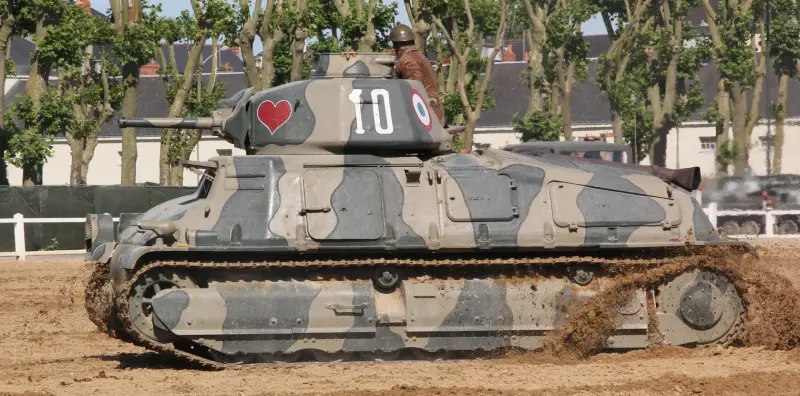
Samyursky S35 in running condition. The tank was visited by the Germans; the roof of the observation turret was cut off and a double-leaf hatch was welded on. The commander sits marching-style on the aft hatch.
French Tanks The interwar period receives very contradictory assessments. We traditionally criticize them, and not always to the point. In Western publications, on the contrary, French armor is often placed on the same level as German armor, and even higher. This also applies to the assessment of the best French tank of the 30s - SOMUA S35.
Some believe that, despite all its shortcomings, the tank was truly successful for its time, others call it the best among the worst. Mikhail Baryatinsky I actually wrote it once, that "the French S35 was a tank brought to perfection that met the requirements of the First World War."
Today we will look at the S35 in detail and give it a balanced assessment based on original documents, and not on retellings of dubious publications.
The attention to the design is no coincidence: the tank turned out to be interesting and progressive, but at the same time very French. It can easily be called a showcase of French technologies.
Cavalry is mechanized
To adequately evaluate the design of the S35, you first need to identify under what conditions and for what tasks it was created.
In the early 30s, the French cavalry issued requirements for three types of combat vehicles for long-range reconnaissance (AMD), short-range reconnaissance (AMR) and combat with enemy tanks (AMC). The niche of “patrol on wheels” was occupied by the successful armored car AMD 35 from Panhard.
Renault received orders for the AMR 33 and AMC 34 tanks, but they did not go into large production.
Firstly, the cars turned out to be very problematic: the extremely cheap chassis were not reliable and often broke down.
Secondly, in 1934 the cavalry demanded that the AMC armor be strengthened to 40 mm. This put an end to the improved (not in terms of reliability!) AMC 35 from Renault.
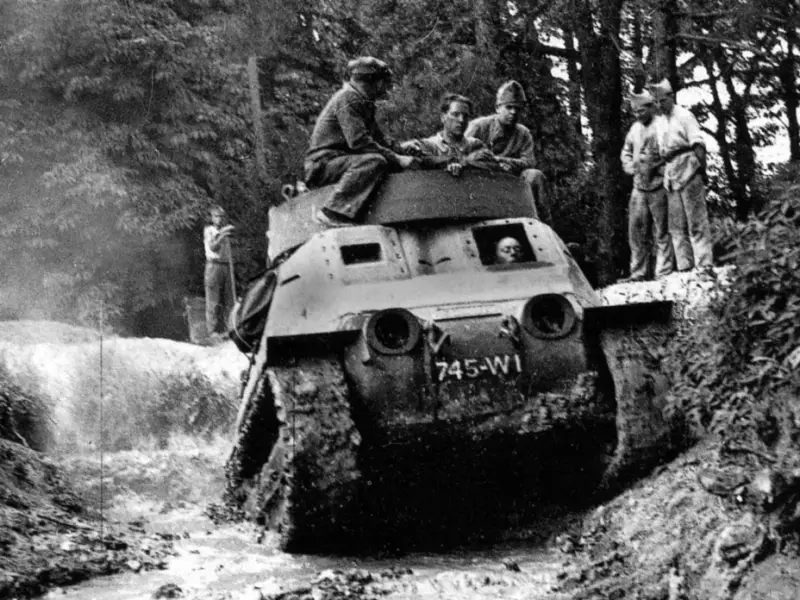
S35 prototype with turret weight mock-up being tested. The front part of the hull will be redone in the future.
Frustrated, the military turned to SOMUA with a proposal to develop a main tank for cavalry. It was envisioned as a three-seater vehicle with a 47 mm caliber gun and 40 mm armor for protection against light anti-tank guns. The average speed should be 30 km/h with a range of 200 km.
In general, the new tank was required to have good mobility on roads, but cross-country ability was not so important.
In April 1935, SOMUA presented the prototype AC 3, the future S35. It took only seven months to detail the project and assemble the prototype tank; taking into account the original design, the time frame was very tight. Tests revealed childhood illnesses, but overall it became clear that the tank was successful. By March 1936, the design was more or less finalized, and the tank was ready for production. On March 25, the AC 3 entered service under the designation AMC 1935 S, although history it entered as SOMUA S35.
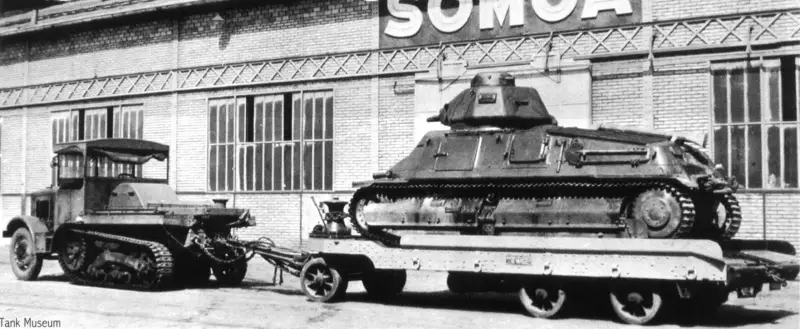
S35 prototype on a 20-ton platform with a SOMUA MCG half-track tractor. The tank has an APX 1 turret with a 47 mm SA 34 cannon; mass production of the usual SA 35 gun has not yet begun.
In general, the history of the creation of the S35 is hardly very interesting. The engineers clearly understood what they needed to do, presented a successful implementation and calmly brought it to fruition. Compare with the history of Pz. Kpfw. III, when the Germans redesigned the chassis several times, then gave up and made a new chassis, failed the production plan and redesigned it again.
Maximum casting
Hotchkiss was the first to assemble tanks from large cast parts. However, according to the layout and shape of the hull her tank H 35 turned out to be quite simple and did not use all the casting possibilities.
SOMUA engineers went even further and designed a fully cast body with unusual geometry. It was bolted together from four large parts. The lower part (armored tank) consisted of two longitudinal halves; the turret box and the rear part were placed on it. The seams were sealed against leaks.
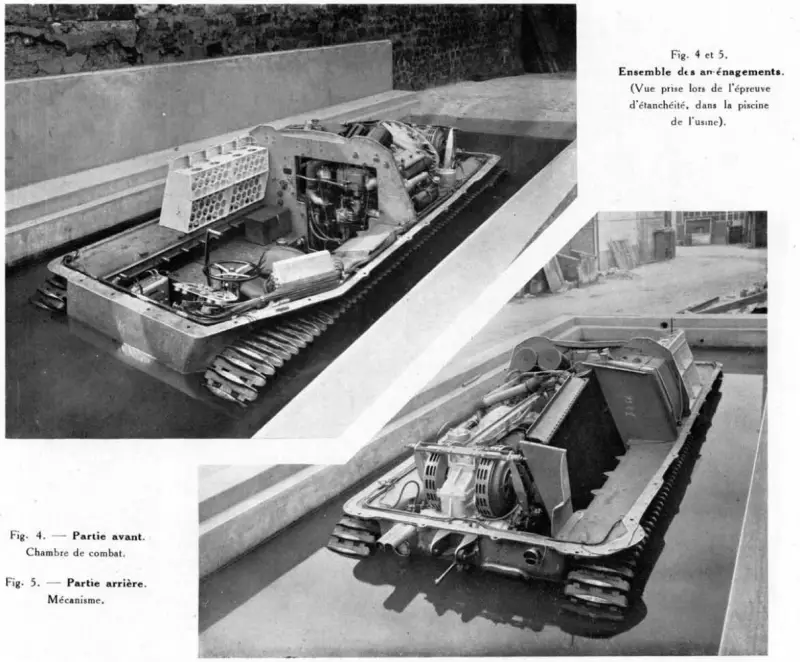
The tank without the upper parts of the hull undergoes leak testing. The driver's workplace, ammunition stowage and the layout of the engine and transmission compartment are clearly visible.
Overall, the S35 was a small, narrow tank that fit on a 20-ton platform. To fit in the width, the chassis was retracted as much as possible into the dimensions of the hull, making the armored vehicle a complex shape. The suspension units were attached to the protruding part of the side, over which the upper branch of the caterpillar passed. Inside there is additional space for the fuel tank, oil tank, gearbox rods and other parts. Compare with the bottom of the H 35, which looks more like a simple box.
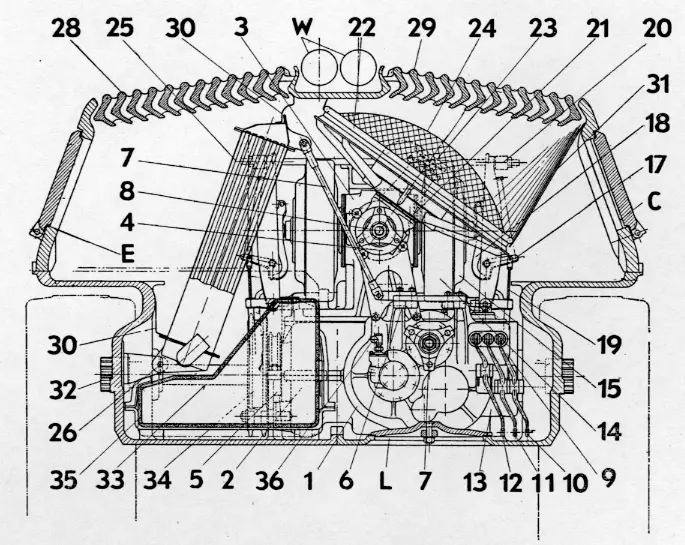
This section clearly shows the complex geometry of the hull.
The thickness of the main sections of the S35 hull armor was 35–47 mm depending on the angle. This was enough for complete protection against machine guns and 20 mm autocannons. 37-mm guns penetrated armor, but not with every shot.
Thus, most German tanks and armored vehicles in 1940 could not reliably hit the S35. There is a known case where a SOMUA used up all its ammunition and left the battle with 29 marks on its armor without serious damage.
Alleged Czech roots
In many articles you can read that the chassis and gearbox of the S35 were made under the influence of the Czech tank LT vz. 35. It’s amazing how tenacious such a gross misconception turned out to be.
Firstly, there are no similarities in the gearbox between the S35 and LT vz. There is no 35 at all, but here we are getting ahead of ourselves.
Secondly, both tanks were created at approximately the same time in parallel.
And thirdly, even earlier developments by Skoda are similar only in the type of suspension components. In general, the S35 could boast of an original design with unusual solutions.
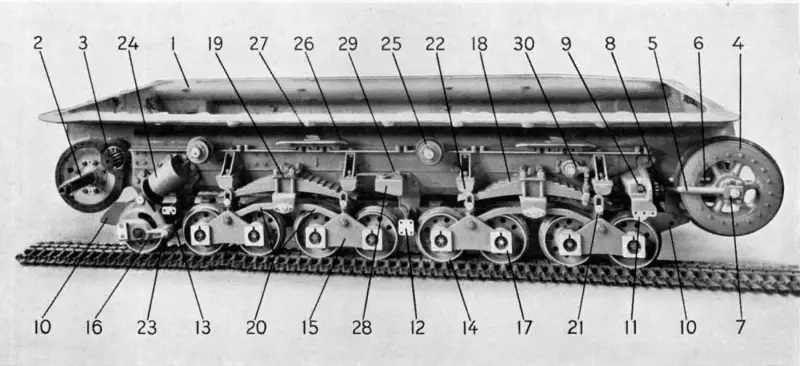
View of the chassis. Number 28 is a grease nipple for lubricating the track joints.
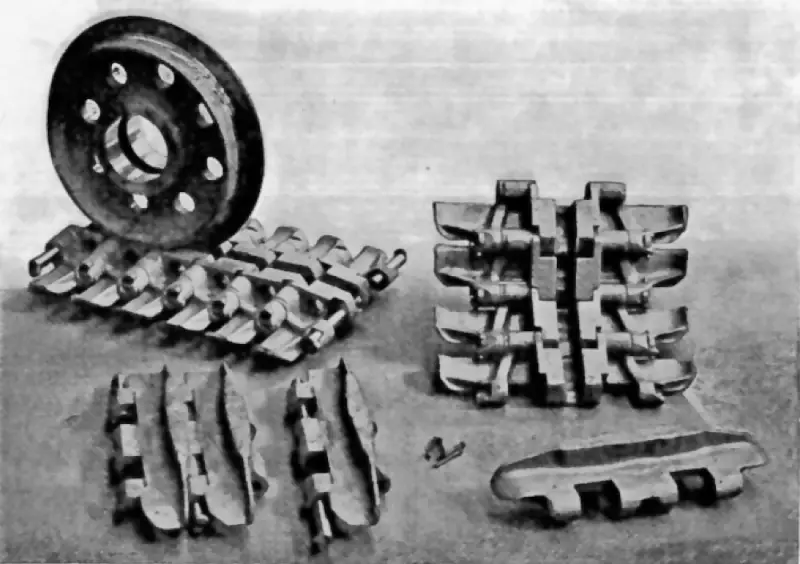
Track roller with a central flange and early tracks with a pitch of 75 mm. The S35 tracks differed from the typical designs of those years; instead of one long pin, the tracks were held together by two short ones.
In the 30s, the French usually used two types of tracks on tanks. For example, the Char B1 had massive tracks with shoes mounted on two rails. On these rails rolled road wheels with flanges that prevented them from moving off the track. The R 35 had English-type tracks with small, lightweight tracks that had guide ridges.
In terms of design, the S35 took an intermediate position. Its caterpillar was made up of small tracks 360 mm wide with a pitch of 105 mm (75 mm on the first 50 tanks), but they did not have ridges. In the center of the tracks there were recesses along which the flanges of steel road wheels rolled.
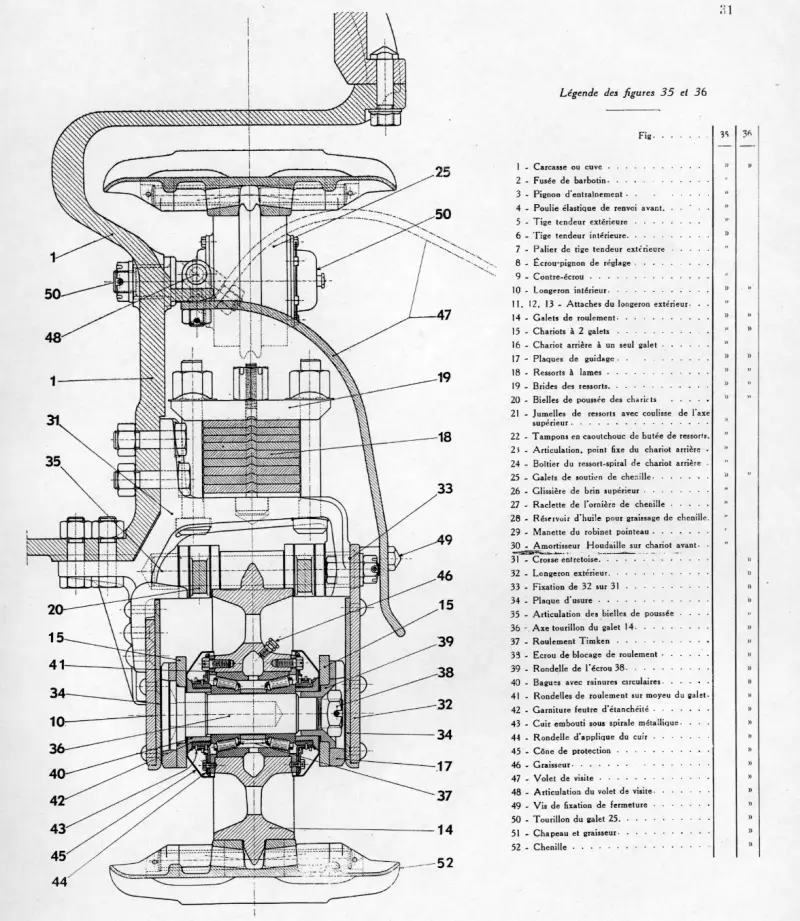
Drawing of mounting suspension units. You can clearly see how complex the geometry of the cast body was.
Each side had 9 road wheels with a diameter of 300 mm. The rear one had an independent spring suspension, the rest were combined into two-roller bogies and locked in fours on leaf springs. The first suspension unit was supplemented with a hydraulic shock absorber. Between the second and third bogies there was an oil can for lubricating the track joints. The upper branch lay on two skids and two supporting rollers. The chassis was covered with removable and folding armor plates.
The narrow S35 was prone to rollover, and its low-mounted sloths limited off-road ability. However, on the roads the tank showed its best side. Its suspension distributed the load evenly and provided a very smooth ride. On the improved S40 model, sloths were placed higher, but its production did not have time to begin due to defeat.
Engine and transmission
SOMUA did not have a suitable engine, so for the S35 it bought engine plans from Janvier, Sabin et Cie. Sometimes it is presented as if the engine was developed by a contractor commissioned by SOMUA. Another ridiculous misconception: the company Janvier, Sabin et Cie was closed back in 1928. In essence, SOMUA bought the blueprints for an abandoned development.
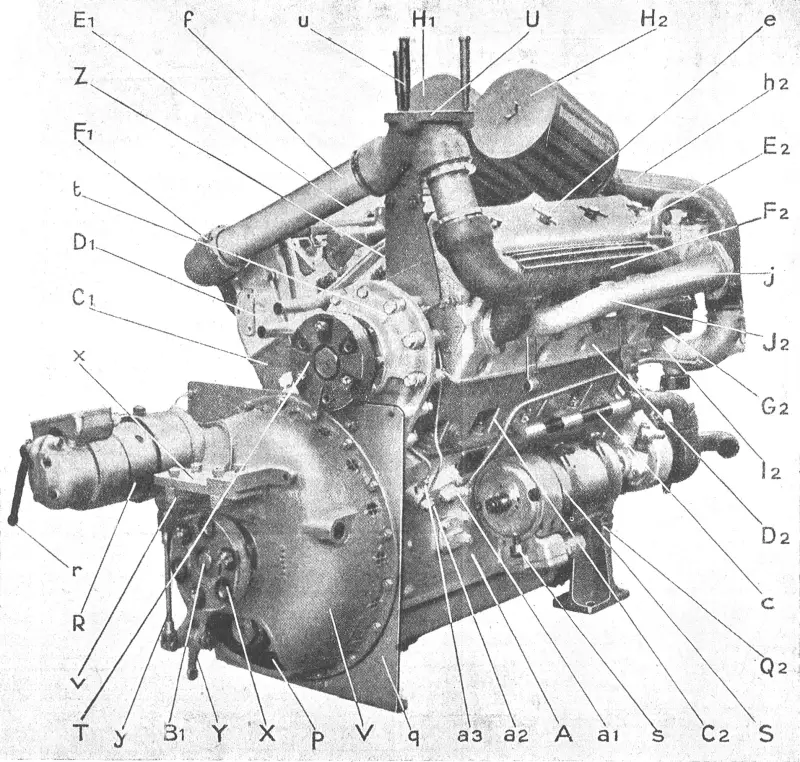
S35 engine, view of the clutch and gear guitar of the second power flow drive. The air filters are visible from above.
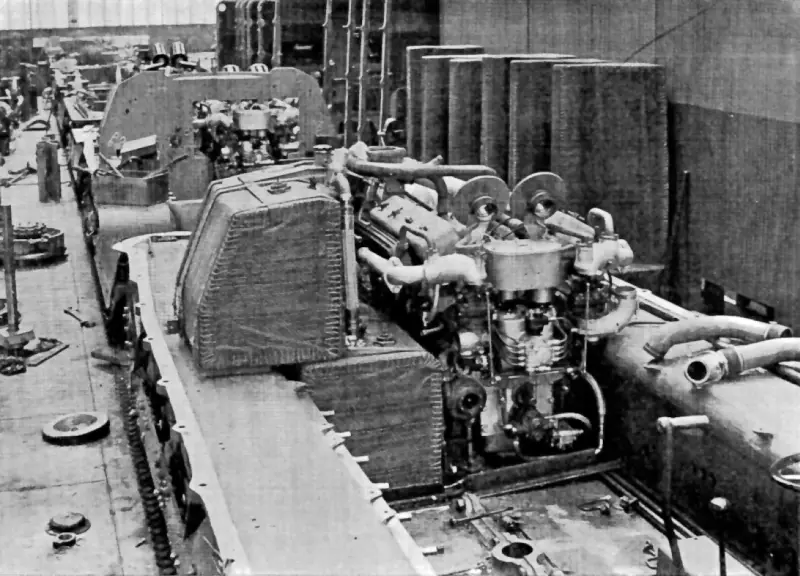
A tank being assembled at a factory. To the left of the engine are two fuel tanks.
The S35 was equipped with a 8-liter V-shaped 12,7-cylinder gasoline engine. It produced 190 hp. With. at 2 rpm and 000 l. With. at 220 rpm, according to Soviet data, although the French indicate a limit of 2 rpm. Specific power 500 l. s./t cannot be called high, but the high-torque engine and successful transmission gave an average speed of 2 km/h on the roads. The maximum design speed was 300 km/h at 11,3 rpm.
The engine was located on the left side. To the right of it were placed two protected fuel tanks with a total capacity of 410 liters. This was enough for 240 kilometers on roads (for comparison: the cruising range of the Pz. Kpfw. III is only 165 km). Note that the tank did not have any external fuel tanks; they are often passed off as hanging boxes for storing things. An automatic fire extinguishing system consisting of three fire extinguishers was provided.
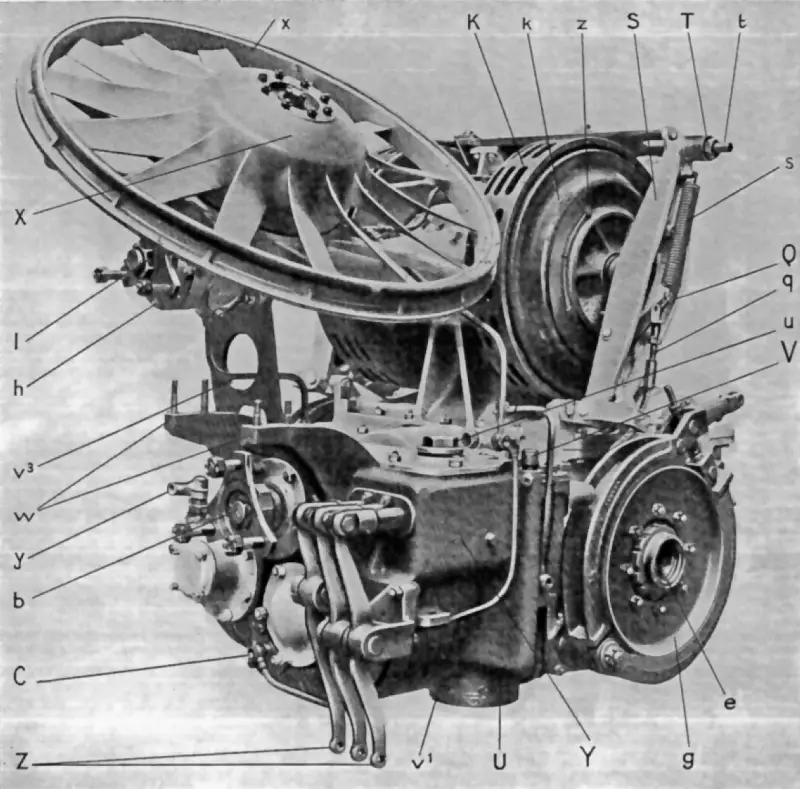
The gearbox, steering mechanism, drum brakes and cooling system drive were assembled into one compact unit.
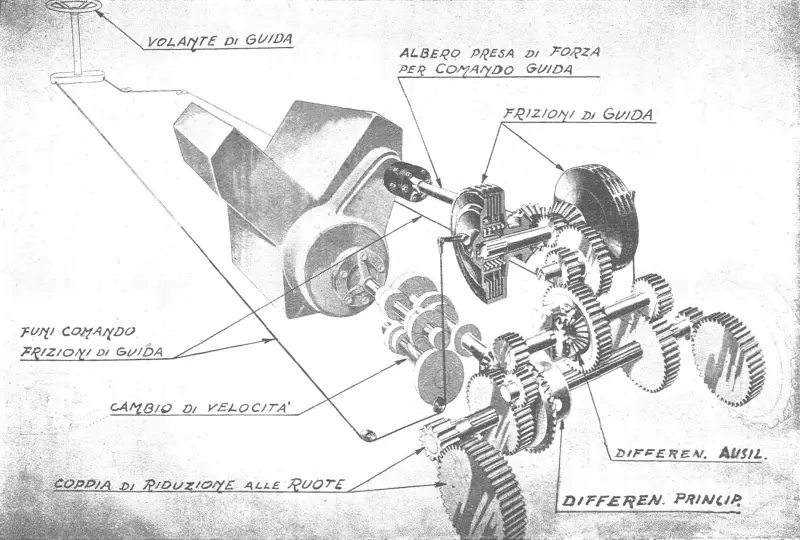
Transmission diagram from Italian manual. You can see how the power flows: the lower one through the gearbox, the upper one through the clutch (frizioni di guida). The steering wheel included clutches via a cable system.
The transmission was located behind the engine. It was one of the best developments of its time, so it’s worth talking about it in more detail.
A five-speed gearbox, a dual-flow turning mechanism, a cooling system drive and drum brakes were combined into one unit. The turning mechanism consisted of two differentials and two clutches. The lower one was connected to the engine through the gearbox, and the upper one directly through the clutch. To turn, one of the clutches was engaged, and the upper differential began to rotate, accelerating one axle shaft of the lower differential and slowing down the other.
Thus, each gear had its own turning radius; in addition, the tank could turn unsteadily on the spot.
The design turned out to be elegant in its own way.
The upper differential drive also rotated the cooling system fan, so a separate drive was not required for it. In addition, the fan was located next to the clutches to blow air over them. Like the engine, the transmission was shifted to the left side, and water and oil radiators were placed to the right of it.
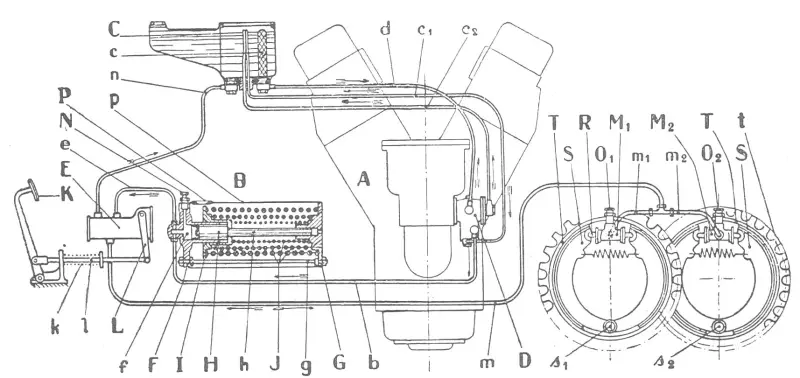
Foot brake diagram. The pedal controls the brake servo inside the road wheels.
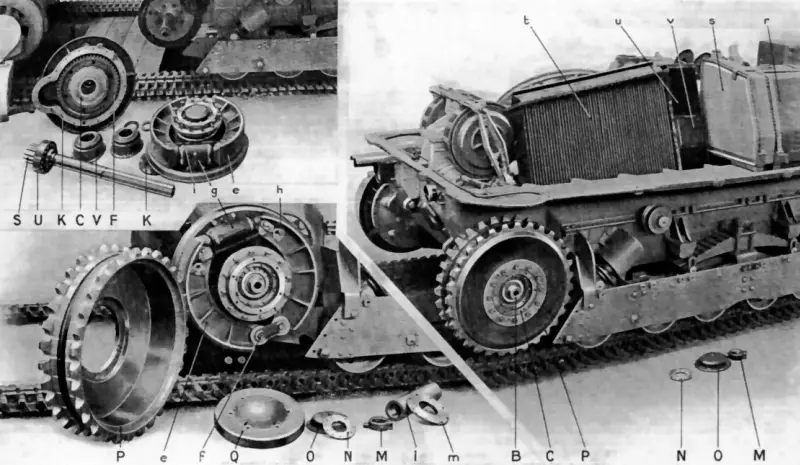
View of the brakes and final drive.
The driver controlled the tank using a steering wheel similar to a car steering wheel. His turn engaged the appropriate clutch. The tank had two brake systems. The pedal turned on the hydraulic servo drive of the shoe brakes inside the road wheels, this drive took the engine power. The lever tightened the drum brakes on the axle shafts of the lower differential. In essence, it was the lever of a manual oil pump. By switching the distribution mechanism, the driver could block both tracks or just one, so the handbrake made it possible to maintain mobility even if the turning mechanism broke down.
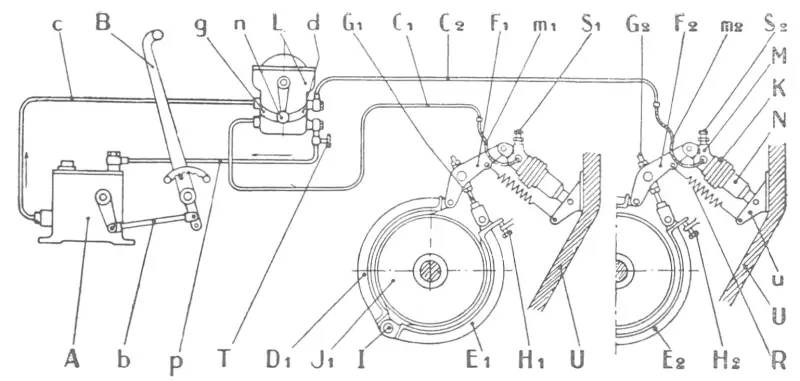
Handbrake diagram. A switch on the dashboard made it possible to brake one of the tracks or both at once.
The S35 engine and transmission were combined into two large blocks, making them easier to dismantle. However, you need to get to them first. The design of early tanks required the removal of the upper hull parts and firewall, which was only possible in an equipped workshop. Six workers could complete a tank overhaul in 23 and a half hours.
Starting with the 51st tank, the design was improved. Now, to replace the engine and transmission, only the upper aft part had to be removed, and the operating time was reduced to 13 hours.
In general, the maintainability of early tanks left much to be desired.
Turret and weapons
In terms of turret, armament and crew composition, the S35 was similar to the later Char D2, so we will limit ourselves to a brief description.
The tank was equipped with an APX 1 CE (chemin élargi) cast turret with electric drive. It was similar to the APX 4 turrets of the D2 and B1 tanks, but with an increased shoulder strap of 1 mm. The thickness of the armor reached 130 mm at the forehead and 56 mm at the inclined sides. The armament consisted of a 45 mm machine gun and a 7,5 mm SA 47 cannon with a 35-caliber barrel. Despite its modest appearance, it was quite a powerful weapon. It could confidently hit any German tank or armored car in any projection, except perhaps the latest StuG III with 32 mm frontal armor. The ammunition stowage for 50 rounds was located on the starboard side.
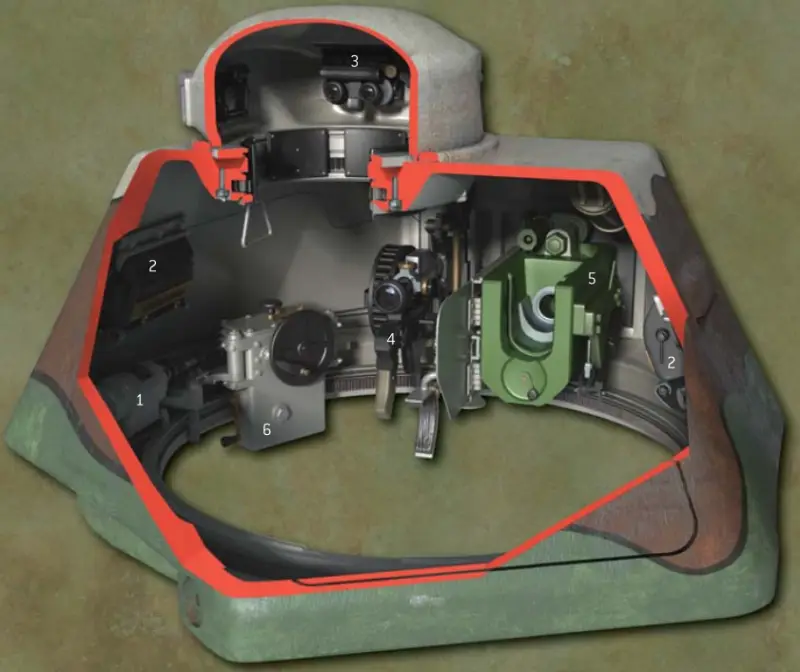
Interior of the S35 tower. It is clearly visible that it was not so easy for the radio operator to help with reloading, dodging flying cartridges.
For all-round visibility there was a rotating turret with three observation devices: a PPL RX 160 periscope with a viewing angle of 68 degrees, a binocular periscope with an angle of 10 degrees and fourfold magnification, as well as a viewing slit behind the armored shutter with an angle of 114 degrees. If the instruments were damaged, the commander could quickly replace the PPL RX 160 periscope or open the shutter. There were two glass blocks on the sides of the tower, and the shape of the tower prevented them from being hit by frontal fire.
Single tower was the main drawback of the S35.
Firstly, the commander was overloaded with responsibilities, because he had to monitor the battle, give instructions to the crew and fire from a cannon and machine gun.
Secondly, his work was poorly organized. The commander maintained a 360-degree view from the turret. Having discovered the target, he sat lower and began turning the tower. But in this position, the entire forward view was limited by the narrow sight field! In addition, there were no hatches on the roof of the tower. To get a better look around, the commander had to lower the aft hatch, which served as a traveling seat. It turns out that the commander often changed positions in the tower, wasting time.
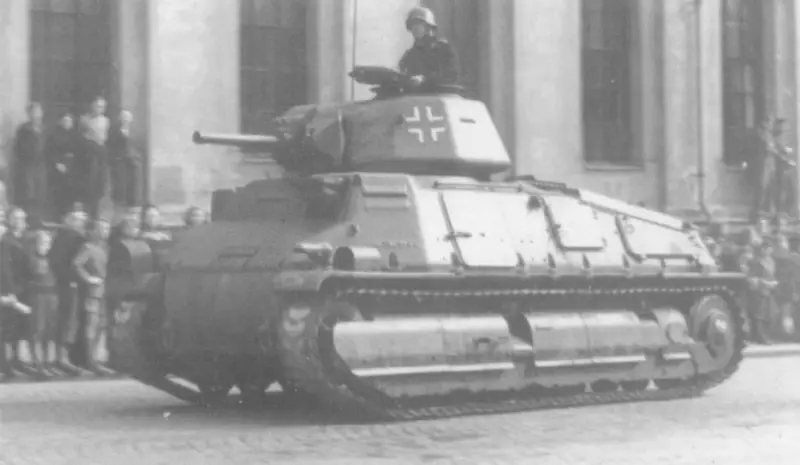
The Germans didn’t like the tower either, so they often cut off the roof of the observation tower and welded a double hatch. On this tank, the original turret was removed altogether, and a viewing turret from a Pz. was welded on. Kpfw. II.
Another chronic problem with French tanks was radio communications.
The quality of the radio stations was poor, and in addition they were produced in insufficient quantities. Because of this, many S35s never received radios. Fortunately, the enlarged turret shoulder strap allowed the radio operator to help reload the gun, at least somehow relieving the commander. There is a known case when an S35 went into battle with a crew of two without a radio operator.
Summing up
First of all, the S35 was truly a cavalry tank, capable of being in the right place at the right time. A large fuel supply and a reliable chassis made it possible to cover significant distances under its own power at a sufficient average speed.
Weighing 19,5 tons, SOMUA passed over most bridges and was easily transported on 20-ton flatbeds. The chassis provided a very smooth ride on roads, but off-road the tank performed mediocrely, which was not critical for cavalry.
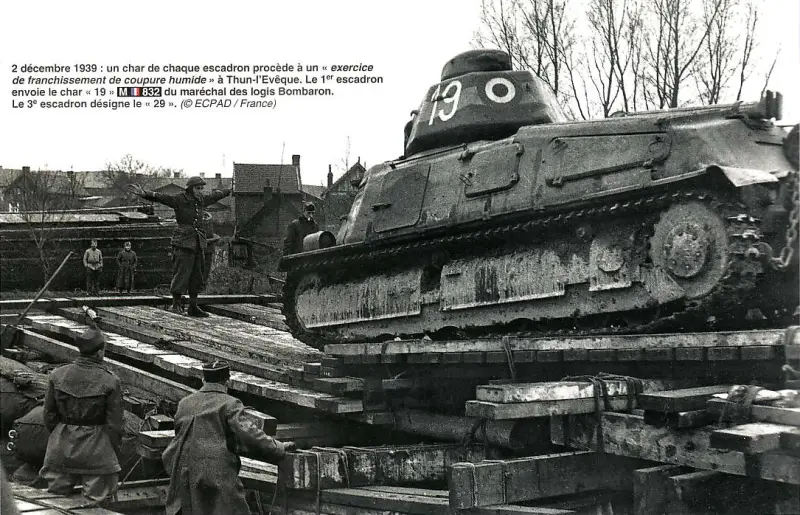
S35 in ferry training, 2 December 1939.
The S35 featured a distinctive but quite advanced chassis for its time. Suffice it to say that it was the second tank in the world with a dual-flow turning mechanism.
However, we had to pay a lot for the automatic fire extinguishing system, servo-driven brakes, shock absorbers, dual-flow transmission and other technical delights. SOMUA turned out to be a very expensive tank, almost five times more expensive than the R 35, and its production lagged behind military needs.
The S35's design was advanced but not overly complex. Unlike the Germans, French engineers were quickly able to find a successful compromise. For example, on Pz. Kpfw. III tried to install a three-radius, two-thread turning mechanism, but could not get it to work properly and returned to a single-thread one. The French installed a single-radius mechanism with simple control through a system of cables. And it worked well!
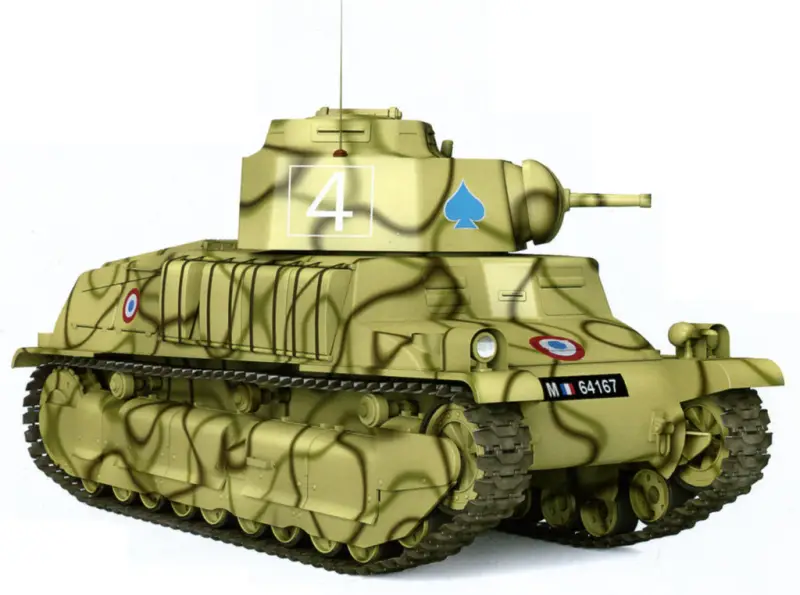
Reconstruction of the appearance of the S40 with a two-seat FCM turret. Note the improved chassis with raised idlers.
Overall, the S35 turned out to be a fairly balanced tank. Its main advantage was the absence of pronounced shortcomings: good mobility, sufficient armor and good, but not record-breaking, weapons.
However, the picture is spoiled by an unsuccessful single tower. In 1942, FCM engineers, secretly from the Germans, designed a two-seat turret for the S35 on a 1 mm chase with a polycom and a sunroof. This work shows that the problem was in the minds of the military, but the chassis itself made it possible to arm the tank more successfully.
Sources:
Technical description of the tank, May 1938 (Notice descriptive du char 1935 S).
Manual for driving and maintaining a tank, November 1938 (Notice de conduite et d'entretien du char 1935 S).
Italian manual, September 1941 (Istruzione sulla condotta e sulla manutenzione del carro armato SOMUA).
Steven J. Zaloga. Panzer III vs SOMUA S 35: Belgium 1940 – Osprey Publishing (Duel series, no. 63).
Pascal Danjou. Trackstory n. 1: SOMUA S 35 – Editions Du Barbotin
Yuri Pasholok. The best French tank of the pre-war period (warspot.ru).
Information